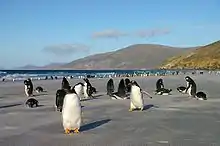Gentoo penguin
The gentoo penguin (/ˈdʒɛntuː/ JEN-too) (Pygoscelis papua) is a penguin species (or possibly a species complex) in the genus Pygoscelis, most closely related to the Adélie penguin (P. adeliae) and the chinstrap penguin (P. antarcticus). The earliest scientific description was made in 1781 by Johann Reinhold Forster with a type locality in the Falkland Islands. They call in a variety of ways, but the most frequently heard is a loud trumpeting which the bird emits with its head thrown back.[2]
| Gentoo penguin | |
|---|---|
| At Brown Bluff, Tabarin Peninsula | |
| Scientific classification | |
| Kingdom: | Animalia |
| Phylum: | Chordata |
| Class: | Aves |
| Order: | Sphenisciformes |
| Family: | Spheniscidae |
| Genus: | Pygoscelis |
| Species: | P. papua |
| Binomial name | |
| Pygoscelis papua (Forster, 1781) | |
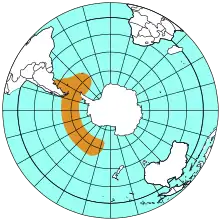 | |
| Distribution of the gentoo penguin | |
Names
The application of gentoo to the penguin is unclear. Gentoo was an Anglo-Indian term to distinguish Hindus from Muslims. The English term may have originated from the Portuguese gentio ("pagan, gentile"). Some speculate that the white patch on the bird's head was thought to resemble a turban.[3]
It may also be a variation of another name for this bird, "Johnny penguin", Johnny being Juanito in Spanish and sounds vaguely like gentoo.[4][5][6] The Johnny rook, a predator, is likely named after the Johnny penguin.[7]
The specific name papua is a misnomer; in the original description, Johann Reinhold Forster, a naturalist who had circumnavigated the world with Captain James Cook, mistakenly assumed that the species occurred in Papua (New Guinea), the closest gentoos actually being over 6000 km to the south (on Macquarie Island).[3] There are no penguins in New Guinea.[8] Others trace the error to a "possibly fraudulent claim" in 1776 by French naturalist Pierre Sonnerat, who also alleged a Papuan location for the king penguin despite never having been to the island himself.[9]
Taxonomy
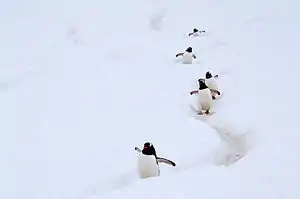
The gentoo penguin is one of three species in the genus Pygoscelis. Mitochondrial and nuclear DNA evidence suggests the genus split from other penguins around 38 million years ago, about 2 million years after the ancestors of the genus Aptenodytes. In turn, the Adelie penguins split off from the other members of the genus around 19 million years ago, and the chinstrap and gentoo finally diverged around 14 million years ago.[10]
Two subspecies of this penguin are recognised: Pygoscelis papua papua (the subantarctic Gentoo) and the smaller Pygoscelis papua ellsworthi (the Antarctic Gentoo).[11][12] A recent study suggests that the Gentoo penguin should be split into a species complex of four morphologically similar but separate species: the northern gentoo penguin (P. papua sensu stricto), the southern gentoo penguin (P. ellsworthi), the eastern gentoo penguin (P. taeniata), and the newly-described South Georgia gentoo penguin (P. poncetii).[13][14]
Description
The gentoo penguin is easily recognized by the wide white stripe extending like a bonnet across the top of its head and its bright orange-red bill. It has pale whitish-pink webbed feet and a fairly long tail – the most prominent tail of all penguin species. Chicks have grey backs with white fronts. As the gentoo penguin waddles along on land, its tail sticks out behind, sweeping from side to side, hence the scientific name Pygoscelis, which means "rump-tailed".[15]
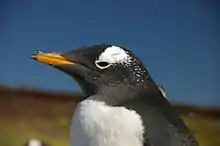
Gentoos reach a height of 51 to 90 cm (20 to 35 in),[16][17] making them the third-largest species of penguin after the emperor penguin and the king penguin. Males have a maximum weight of about 8.5 kg (19 lb) just before molting, and a minimum weight of about 4.9 kg (11 lb) just before mating. For females, the maximum weight is 8.2 kg (18 lb) just before molting, but their weight drops to as little as 4.5 kg (9.9 lb) when guarding the chicks in the nest.[18] Birds from the north are on average 700 g (1.5 lb) heavier and 10 cm (3.9 in) taller than the southern birds. Southern gentoo penguins reach 75–80 cm (30–31 in) in length.[19] They are the fastest underwater swimmers of all penguins, reaching speeds of up to 36 km/h (22 mph).[20] Gentoos are well adapted to extremely cold and harsh climates.
Breeding
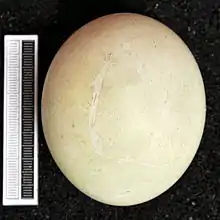
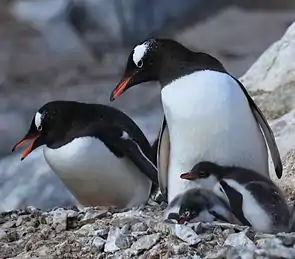
The breeding colonies of gentoo penguins are located on ice-free surfaces. Colonies can be directly on the shoreline or can be located considerably inland. They prefer shallow coastal areas and often nest between tufts of grass. In South Georgia, for example, breeding colonies are 2 km inland. In colonies farther inland, where the penguins nest in grassy areas, they shift location slightly every year because the grass will become trampled over time.
Gentoos breed on many sub-Antarctic islands. The main colonies are on the Falkland Islands, South Georgia and the South Sandwich Islands, and Kerguelen Islands; smaller colonies are found on Macquarie Island, Heard Islands, Crozet Islands, South Shetland Islands, and the Antarctic Peninsula. The total breeding population is estimated to be over 600,000 birds. Gentoos breed monogamously, and infidelity is typically punished with banishment from the colony.[21] Nests are usually made from a roughly circular pile of stones and can be quite large, 20 cm (7.9 in) high and 25 cm (9.8 in) in diameter. The stones are jealously guarded and their ownership can be the subject of noisy disputes and physical attacks between individuals. They are also prized by the females, even to the point that a male penguin can obtain the favors of a female by offering her a choice stone.
Two eggs are laid, both weighing around 130 g (4.6 oz). The parents share incubation, changing duty daily. The eggs hatch after 34 to 36 days. The chicks remain in the nests for around 30 days before joining other chicks in the colony and forming crèches. The chicks molt into subadult plumage and go out to sea at around 80 to 100 days.
Diet
Gentoos live mainly on crustaceans, such as krill, with fish making up only about 15% of the diet. They are, however, opportunistic feeders, and around the Falklands are known to take roughly equal proportions of fish (Patagonotothen sp., Thysanopsetta naresi, Micromesistius australis), squat lobsters (Munida gregaria), and squid (Loligo gahi, Gonatus antarcticus, Moroteuthis ingens).
Physiology
The gentoos' diet is high in salt as they eat organisms with relatively the same salinity as sea water, and this can lead to complications associated with high sodium concentrations in the body, especially for gentoo chicks. To counteract this, gentoos as well as many other marine bird species have a highly developed salt gland located above their eyes that takes the high concentration of sodium within the body and produces a highly saline-concentrated solution that drips out of the body from the tip of the beak.[22]
Gentoo penguins do not store as much fat as the Adelie penguin, their closest relative: gentoos require less energy investment when hunting because the net gain of energy after hunting is greater in gentoos than Adelies.[23] As embryos, gentoos require a lot of energy in order to develop. Oxygen consumption is high for a developing gentoo embryo. As the embryo grows and requires more oxygen, the amount of consumption increases exponentially until the gentoo chick hatches. By then, the chick is consuming around 1800 mL O2 per day.[24]
Predators
.jpg.webp)
In the sea, leopard seals, sea lions, and killer whales are all predators of the gentoo. On land, no predators of full-grown healthy gentoo penguins exist. Skuas and giant petrels regularly kill many chicks and steal eggs; Petrels will kill injured and sick adult gentoos. Various other seabirds, such as the kelp gull and snowy sheathbill, will also snatch chicks and eggs. Skuas on King George Island have been observed attacking and injuring adult gentoo penguins in apparent territorial disputes.[25]
Conservation status
As of 2019, the IUCN Red List lists the gentoo as least concern, although rapid declines in some key areas are believed to be driving a moderate overall decline in the species population. Examples include Bird Island, South Georgia, where the population has fallen by two-thirds over 25 years.[1]
Influence
The Linux distribution Gentoo Linux is named after the Gentoo penguin. This is a nod to the fact that the penguin is the fastest swimming penguin, as Gentoo Linux aims to be a high performance operating system.[26]:383
Gallery
 Adult gentoo confronting a southern giant petrel (Macronectes giganteus) that has killed a chick
Adult gentoo confronting a southern giant petrel (Macronectes giganteus) that has killed a chick_on_nest.jpg.webp) Gentoo penguin on nest
Gentoo penguin on nest A gentoo penguin swimming
A gentoo penguin swimming Juvenile gentoos on Petermann Island
Juvenile gentoos on Petermann Island Gentoo colony on Carcass Island in the Falklands
Gentoo colony on Carcass Island in the Falklands A leopard seal eating an adult gentoo
A leopard seal eating an adult gentoo
Subspecies
- Pygoscelis papua papua
- Pygoscelis papua ellsworthi
References
- BirdLife International (2018). Pygoscelis papua. The IUCN Red List of Threatened Species 2018. doi:10.2305/IUCN.UK.2018-2.RLTS.T22697755A132600694.en
- Woods, R.W. (1975) Birds of the Falkland Islands, Antony Nelson, Shropshire, UK.
- Campbell, David G. (2002). The Crystal Desert: Summers in Antarctica. Houghton Mifflin Harcourt. p. 278. ISBN 978-0-547-52761-1.
- Chester, Jonathan (1996). Penguins: Birds of Distinction. Australia: Penguin Books. p. 42. ISBN 978-0-14-025968-1.
Until the 1930s the gentoo was generally known in the Falklands as the Johnny penguin.
- "gentoo penguin". American Heritage Dictionary of the English Language (5 ed.).
- Beaglehole, J.C. (2017). The Journals of Captain James Cook on his Voyages of Discovery. II. Taylor & Francis. p. 910. ISBN 978-1-351-54324-8.
In the eighteenth century English-speaking sealers commonly called [the gentoo] the Johnny Penguin. The Spanish translation of this was 'Juanito', which has degenerated into Gentoo.
- Gorman, James (1990). The Total Penguin. Prentice Hall. p. 87. ISBN 978-0-13-925041-5.
Sealers called it the "Johnny penguin" or "John penguin." In that incarnation, it seems to have given its name to the striated caracara, a bird of prey that feeds on young gentoo penguins in the Falklands and is called the "Johnny rook."
- Troelstra, Anne S. (2017). Bibliography of Natural History Travel Narratives. Brill. pp. 411–. ISBN 978-90-04-34378-8.
- Gray, Jeannie; Fraser, Ian (2013). Australian Bird Names. Csiro. p. 42. ISBN 978-0-643-10471-6.
- Baker AJ, Pereira SL, Haddrath OP, Edge KA (2006). "Multiple gene evidence for expansion of extant penguins out of Antarctica due to global cooling". Proc Biol Sci. 273 (1582): 11–17. doi:10.1098/rspb.2005.3260. PMC 1560011. PMID 16519228.
- environment.gov.au. "Pygoscelis papua papua — Gentoo Penguin (subantarctic)". Retrieved 2019-12-12.
- itis.gov. "Pygoscelis papua (J. R. Forster, 1781)". Retrieved 2019-12-12.
- Tyler, Joshua; Bonfitto, Matthew T.; Clucas, Gemma V.; Reddy, Sushma; Younger, Jane L. (2020). "Morphometric and genetic evidence for four species of gentoo penguin". Ecology and Evolution. 10 (24): 13836–13846. doi:10.1002/ece3.6973. ISSN 2045-7758. PMC 7771148.
- Pertierra, Luis R.; Segovia, Nicolás I.; Noll, Daly; Martinez, Pablo A.; Pliscoff, Patricio; Barbosa, Andrés; Aragón, Pedro; Rey, Andrea Raya; Pistorius, Pierre; Trathan, Phil; Polanowski, Andrea (2020). "Cryptic speciation in gentoo penguins is driven by geographic isolation and regional marine conditions: Unforeseen vulnerabilities to global change". Diversity and Distributions. 26 (8): 958–975. doi:10.1111/ddi.13072. ISSN 1472-4642.
- "Gentoo penguin videos, photos and facts – Pygoscelis papua". Arkive. Archived from the original on 2009-05-20.
- "Pygoscelis papua (gentoo penguin)". Animal Diversity Web.
- Barham, Peter and Barham, Barbara. "Gentoo Penguin – Pygoscelis Papua". Archived from the original on 2008-09-20. Retrieved 2008-09-23.CS1 maint: multiple names: authors list (link)
- "Gentoo penguin videos, photos and facts – Pygoscelis papua". Arkive. Archived from the original on 2012-07-18.
- "Antarctica fact file wildlife, gentoo penguins". coolantarctica.com.
- "Gentoo penguin". BBC Nature. Archived from the original on 2012-02-05.
- Trather, PN; Forcada, J; Atkinson, R; Downie, RH; Shears, JR (December 2008). "Population assessments of gentoo penguins (Pygoscelis papua) breeding at an important Antarctic tourist site, Goudier Island, Port Lockroy, Palmer Archipelago, Antarctica". Biological Conservation. 141 (12): 3019–3028. doi:10.1016/j.biocon.2008.09.006.
Breeding pairs of Pygoscelis papua remained constant throughout the 1996/1997 breeding season. Males observed attempting to breed outside of their original breeding pair were violently rejected from the colony.
- Schmidt-Nielsen, K. (1960). "The Salt-Secreting Gland of Marine Birds". Circulation. 21 (5): 955–967. doi:10.1161/01.cir.21.5.955. PMID 14443123.
- D’Amico, V. L., Coria, N., Palacios, M. G., Barbosa, A., & Bertellotti, M. (2016). "Physiological differences between two overlapped breeding Antarctic penguins in a global change perspective". Polar Biology. 39: 57–64. doi:10.1007/s00300-014-1604-9. hdl:10261/156947. S2CID 17563166.CS1 maint: multiple names: authors list (link)
- Actams, N. J. (1992). "Embryonic metabolism, energy budgets and cost of production of king Aptenodytes patagonicus and gentoo Pygoscelis papua penguin eggs". Comparative Biochemistry and Physiology Part A: Physiology. 101 (3): 497–503. doi:10.1016/0300-9629(92)90501-g.
- February 2014 observation and photo report by Robert Runyard, translator for INACH (Chilean Antarctic Institute).
- Christopher Negus (5 May 2008). Linux Bible: Boot Up to Ubuntu, Fedora, KNOPPIX, Debian, openSUSE, and 11 Other Distributions. John Wiley & Sons. pp. 389–. ISBN 978-0-470-28706-4.
This article incorporates text from the ARKive fact-file "Gentoo penguin" under the Creative Commons Attribution-ShareAlike 3.0 Unported License and the GFDL.
External links
| Wikimedia Commons has media related to: |
| Wikispecies has information related to Pygoscelis papua. |
- 70South – more info on the gentoo penguin
- Gentoo penguin on PenguinWorld
- Gentoo penguins from the International Penguin Conservation website
- www.pinguins.info: information about all species of penguins
- Gentoo penguin images
- Biodiversity at Ardley Island Small place near King Luis Island, special protected area and colony of gentoo penguins.
- Gentoo penguin webcam from the Antarctic – worldwide first webcam with wild penguins; photo quality
- Gentoo penguin media from ARKive

_03.jpg.webp)

